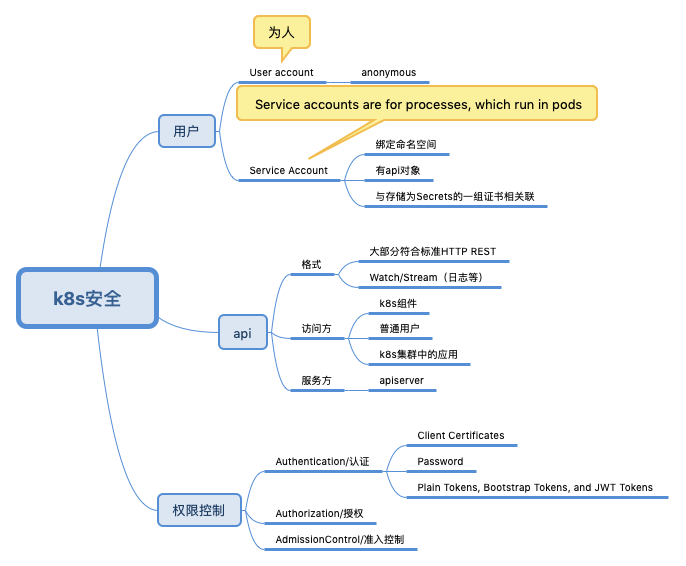简介
火得一塌糊涂的kubernetes有哪些值得初学者学习的? Kubernetes 是透明的,它没有隐藏的内部 API。换句话说 Kubernetes 系统内部用来交互的 API 和我们用来与 Kubernetes 交互的 API 相同。这样做的好处是,当 Kubernetes 默认的组件无法满足我们的需求时,我们可以利用已有的 API 实现我们自定义的特性。

概念
用户
- User accounts are for humans. Service accounts are for processes, which run in pods.
- User accounts are intended to be global. Names must be unique across all namespaces of a cluster, future user resource will not be namespaced. Service accounts are namespaced.
access the API
Controlling Access to the Kubernetes API
- Authentication:即身份验证,这个环节它面对的输入是整个http request。它负责对来自client的请求进行身份校验,支持的方法包括:client证书验证(https双向验证)、basic auth、普通token以及jwt token(用于serviceaccount)。APIServer启动时,可以指定一种Authentication方法,也可以指定多种方法。如果指定了多种方法,那么APIServer将会逐个使用这些方法对客户端请求进行验证,只要请求数据通过其中一种方法的验证,APIServer就会认为Authentication成功;
- Authorization:授权。这个阶段面对的输入是http request context中的各种属性,包括:user、group、request path(比如:/api/v1、/healthz、/version等)、request verb(比如:get、list、create等)。APIServer会将这些属性值与事先配置好的访问策略(access policy)相比较。APIServer支持多种authorization mode,包括AlwaysAllow、AlwaysDeny、ABAC、RBAC和Webhook。APIServer启动时,可以指定一种authorization mode,也可以指定多种authorization mode,如果是后者,只要Request通过了其中一种mode的授权,那么该环节的最终结果就是授权成功。
- Admission Control:从技术的角度看,Admission control就像a chain of interceptors(拦截器链模式),它拦截那些已经顺利通过authentication和authorization的http请求。http请求沿着APIServer启动时配置的admission control chain顺序逐一被拦截和处理,如果某个interceptor拒绝了该http请求,那么request将会被直接reject掉,而不是像authentication或authorization那样有继续尝试其他interceptor的机会。
安全相关的 kubernetes objects
Secrets
- 为什么弄一个Secrets?
- 其它组件(主要是Pod)如何获取Secrets数据?
为什么要弄一个Secrets? 回答为什么的一般方法是:对比前后差异。
Kubernetes secret objects let you store and manage sensitive information, such as passwords, OAuth tokens, and ssh keys. Putting this information in a secret is safer and more flexible than putting it verbatim in a Pod Lifecycle definition or in a container image . 管理敏感信息,如果没有Secrets,这些信息可能被保存在 pod 定义或者 docker 镜像中,有信息泄露的风险(PS:笔者曾把密码写在代码测试类里提交到公司仓库, 结果被几个看源码的小哥发现并使用了)
K8s Secrets 中保存的数据都必须经过 base64加密
apiVersion: v1
kind: Secret
metadata:
name: db-secret
type: Opaque
data:
# base64
carrot-db-username: Y2Fycm90
carrot-db-password: Y2Fycm90
Secrets can be mounted as data volumes or be exposed as environment variables to be used by a container in a pod
- volume 方式, Each key in the secret data map becomes the filename under mountPath. 每一个secret key 会变成 container mountPath 下的一个文件。When a secret being already consumed in a volume is updated, projected keys are eventually updated as well. Kubelet is checking whether the mounted secret is fresh on every periodic sync. 当你改了secret 数据,则容器内的文件内容也能自动同步
- Environment Variables
Service Accounts
A service account provides an identity for processes that run in a Pod. When you (a human) access the cluster (for example, using kubectl), you are authenticated by the apiserver as a particular User Account (currently this is usually admin, unless your cluster administrator has customized your cluster). Processes in containers inside pods can also contact the apiserver. When they do, they are authenticated as a particular Service Account (for example, default).
为什么弄一个Service Accounts?为processes (that run in a Pod) 提供必要的身份认证
apiVersion: v1
kind: ServiceAccount
metadata:
namespace: mynamespace
name: example-sa
Kubernetes 会为一个 ServiceAccount自动创建并分配一个 Secret 对象
$ kubectl get sa -n mynamespace -o yaml
- apiVersion: v1
kind: ServiceAccount
metadata:
creationTimestamp: 2018-09-08T12:59:17Z
name: example-sa
namespace: mynamespace
resourceVersion: "409327"
...
secrets:
- name: example-sa-token-vmfg6
用户的 Pod可以声明使用这个 ServiceAccount
apiVersion: v1
kind: Pod
metadata:
namespace: mynamespace
name: sa-token-test
spec:
containers:
- name: nginx
image: nginx:1.7.9
serviceAccountName: example-sa
等这个 Pod 运行起来之后,我们就可以看到,该 ServiceAccount 的 token,也就是一个 Secret 对象,被 Kubernetes 自动挂载到了容器的 /var/run/secrets/kubernetes.io/serviceaccount 目录下
$ kubectl describe pod sa-token-test -n mynamespace
Name: sa-token-test
Namespace: mynamespace
...
Containers:
nginx:
...
Mounts:
/var/run/secrets/kubernetes.io/serviceaccount from example-sa-token-vmfg6 (ro)
小结一下
- 有哪些资源
- Role 表述对这些资源的操作能力
- User/ServiceAccount 和 Role 绑定在一起,进而拥有Role 所具有的能力
- Pod 和 ServiceAccount 绑定在一起, Pod内进程可以使用 k8s push到本地的ServiceAccount 数据访问 api resource